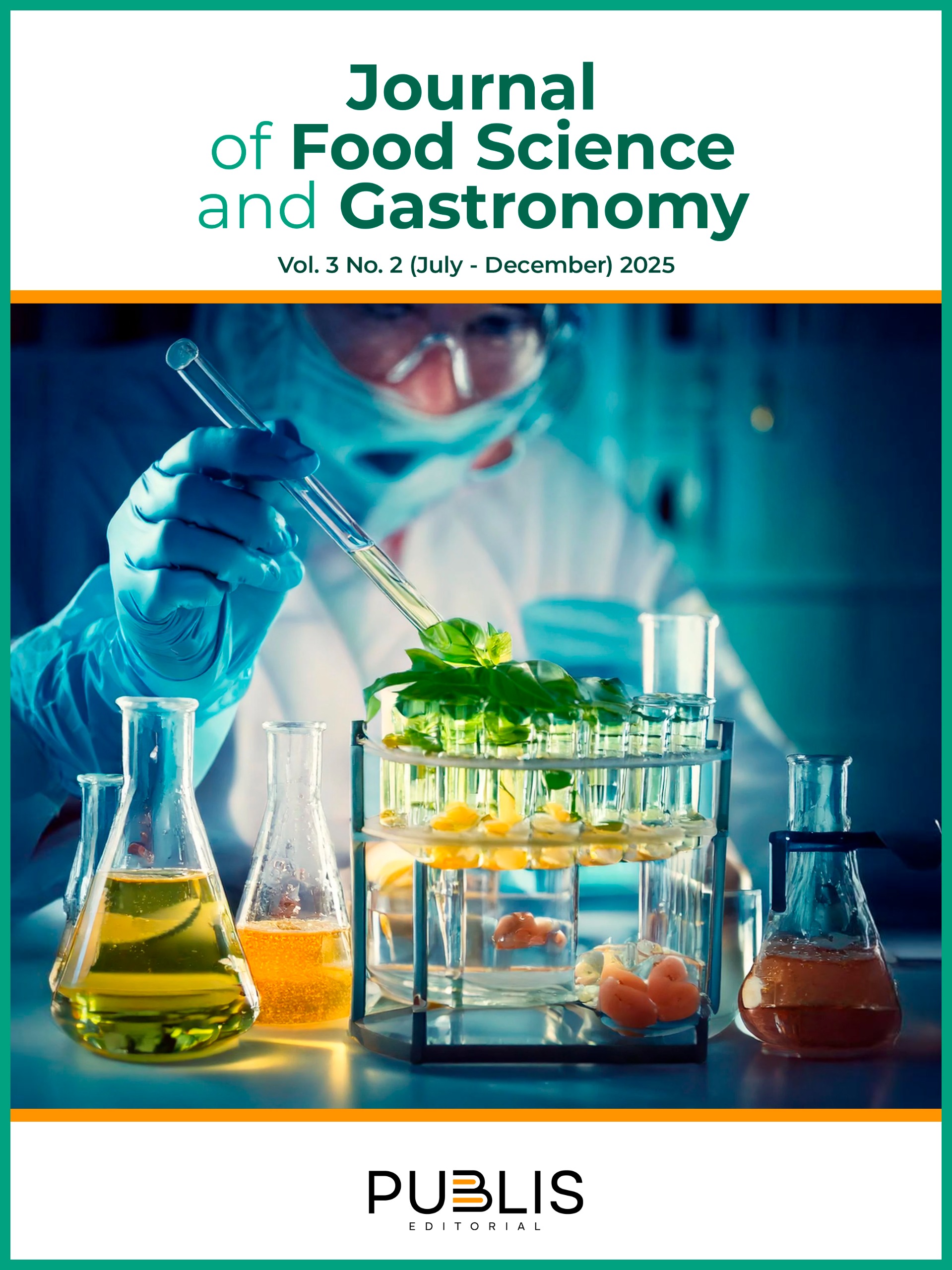Biodegradable chitosan salt coatings as a sustainable strategy for the preservation of fresh tomatoes (Solanum lycopersicum L.)
DOI:
https://doi.org/10.5281/zenodo.16741097Keywords:
fresh tomatoes, chitosan, edible coatings, postharvest preservation, ripening, biodegradabilityAbstract
The consumption of fresh fruits and vegetables, such as tomatoes, is associated with the prevention of chronic diseases; however, their shelf life is limited due to high perishability. This study aimed to evaluate the effect of biodegradable chitosan salt coatings (lactate and acetate) on the postharvest preservation of Solanum lycopersicum cv. Charleston tomatoes. Tomatoes harvested at the breaker stage were coated with 1.5% chitosan lactate and acetate solutions and stored at room temperature for 16 days. Physicochemical (pH, soluble solids, acidity, moisture, weight loss, and firmness) and physiological (ripening stage, wrinkling, and fungal damage) parameters were analyzed. The results showed that chitosan lactate coatings significantly delayed ripening, preserved firmness, and reduced visual deterioration. Chitosan acetate preserved acidity more effectively but showed greater dehydration. No significant differences were found in soluble solids or moisture content. Both coatings demonstrated antimicrobial properties. In conclusion, chitosan salt-based edible coatings, particularly the lactate form, offer a sustainable and effective strategy for extending the shelf life and maintaining the quality of fresh tomatoes.
Downloads
References
Adainoo, B., Thomas, A. L., & Krishnaswamy, K. (2023). A comparative study of edible coatings and freshness paper on the quality of fresh North American pawpaw (Asimina triloba) fruits using TOPSIS-Shannon entropy analyses. Current Research in Food Science, 7, 100541. https://doi.org/10.1016/j.crfs.2023.100541
Antala, P. A., Chakote, A., Varshney, N., Suthar, K., Singh, D., Narwade, A., Patel, K., Gandhi, K., Singh, S., & Karmakar, N. (2025). Phytochemical and metabolic changes associated with ripening of Lycopersicon esculentum. Scientific Reports, 15(1), 10692. https://doi.org/10.1038/s41598-025-95255-9
Aune, D., Giovannucci, E., Boffetta, P., Fadnes, L. T., Keum, N., Norat, T., Greenwood, D. C., Riboli, E., Vatten, L. J., & Tonstad, S. (2017). Fruit and vegetable intake and the risk of cardiovascular disease, total cancer and all-cause mortality-a systematic review and dose-response meta-analysis of prospective studies. International Journal of Epidemiology, 46(3), 1029-1056. https://doi.org/10.1093/ije/dyw319
Bautista B., S., & Bravo L., L. (2004). Evaluación del quitosano en el desarrollo de la pudrición blanda del tomate durante el almacenamiento. Revista Iberoamericana de Tecnología Postcosecha, 6(1), 63-67.
Boehm, J. K., Soo, J., Zevon, E. S., Chen, Y., Kim, E. S., & Kubzansky, L. D. (2018). Longitudinal associations between psychological well-being and the consumption of fruits and vegetables. Health Psychology, 37(10), 959-967. https://doi.org/10.1037/hea0000643
Carrillo-López, A., & Yahia, E. M. (2014). Changes in color-related compounds in tomato fruit exocarp and mesocarp during ripening using HPLC-APcI(+)-mass Spectrometry. Journal of Food Science and Technology, 51(10), 2720-2726. https://doi.org/10.1007/s13197-012-0782-0
Champa, W. A. H., & Weerasooriya, A. D. (2025). A systematic review on plant-based edible coatings for quality improvement and extended postharvest life of fresh fruits and vegetables. Journal of Horticulture and Postharvest Research, 8(2), 177-198. https://doi.org/10.22077/jhpr.2024.8159.1424
Chettri, S., Sharma, N., & Mohite, A. M. (2023). Edible coatings and films for shelf-life extension of fruit and vegetables. Biomaterials Advances, 154, 213632. https://doi.org/10.1016/j.bioadv.2023.213632
Cordenunsi, B. R., Nascimento, J. R. O., & Lajolo, F. M. (2003). Physico-chemical changes related to quality of five strawberry fruit cultivars during cool-storage. Food Chemistry, 83(2), 167-173. https://doi.org/10.1016/S0308-8146(03)00059-1
de la Paz, N., Fernández, M., Hernández, J. A., & García, M. A. (2024). Propiedades físicas y químicas de sales de quitosana obtenidas a partir de quitina de langosta común (Panulirus argus). Journal of Food Science and Gastronomy, 2(2), 8-16. https://doi.org/10.5281/zenodo.13996969
Devirgiliis, C., Guberti, E., Mistura, L., & Raffo, A. (2024). Effect of Fruit and Vegetable Consumption on Human Health: An Update of the Literature. Foods, 13(19), 3149. https://doi.org/10.3390/foods13193149
Devlieghere, F., Vermeulen, A., & Debevere, J. (2004). Chitosan: Antimicrobial activity, interactions with food components and applicability as a coating on fruit and vegetables. Food Microbiology, 21(6), 703-714. https://doi.org/10.1016/j.fm.2004.02.008
Díaz, R., Casariego, A., Rodríguez, J., Martínez, A., & García, M. (2010). Coberturas de quitosana como método de envasado activo en vegetales enteros y cortados. Ciencia y Tecnología de los Alimentos, 20(2), 31-36. https://revcitecal.iiia.edu.cu/revista/index.php/RCTA/article/view/640
Escalante, I., Fon-Fay, F. M., & Pino, J. A. (2024). Efecto de la adición de aceite esencial de canela americana (Ocotea quixos) en la permeabilidad al vapor de agua de películas de quitosana. Journal of Food Science and Gastronomy, 2(1), 6-13. https://doi.org/10.5281/zenodo.13996191
Figueroa, J., Salcedo, J., Aguas, Y., Olivero, R., & Narvaez, G. (2011). Recubrimientos comestibles en la conservación del mango y aguacate, y perspectiva, al uso del propóleo en su formulacion. Revista Colombiana de Ciencia Animal - RECIA, 3(2), 386-400. https://doi.org/10.24188/recia.v3.n2.2011.414
Fujun, L., Qin, B., He, L., & Song, R. (2009). Novel starch/chitosan blending membrane: Antibacterial, permeable and mechanical properties. Carbohydrate Polymers, 78(1), 146-150. https://doi.org/10.1016/j.carbpol.2009.03.021
Galus, S., & Kadzińska, J. (2015). Food applications of emulsion-based edible films and coatings. Trends in Food Science & Technology, 45(2), 273-283. https://doi.org/10.1016/j.tifs.2015.07.011
García, M. A. (2015). Potencialidades de la quitosana como agente antioxidante y antimicrobiano en la industria alimentaria. Ciencia y Tecnología de los Alimentos, 25(1), 69-76. https://revcitecal.iiia.edu.cu/revista/index.php/RCTA/article/view/312
García, M., Casariego, A., Díaz, R., & Roblejo, L. (2014). Effect of edible chitosan/zeolite coating on tomatoes quality during refrigerated storage. Emirates Journal of Food and Agriculture, 26(3), 238-246. https://doi.org/10.9755/ejfa.v26i3.16620
Getinet, H., Seyoum, T., & Woldetsadik, K. (2008). The effect of cultivar, maturity stage and storage environment on quality of tomatoes. Journal of Food Engineering, 87(4), 467-478. https://doi.org/10.1016/j.jfoodeng.2007.12.031
Gross, K. C., Wang, C. Y., & Saltveit, M. (2003). The commercial storage of fruits, vegetables, and florist and nursery stocks (Agricultural Handbook No. 66). US Department of Agriculture.
Hassan, B., Chatha, S. A. S., Hussain, A. I., Zia, K. M., & Akhtar, N. (2018). Recent advances on polysaccharides, lipids and protein based edible films and coatings: A review. International Journal of Biological Macromolecules, 109, 1095-1107. https://doi.org/10.1016/j.ijbiomac.2017.11.097
Kibar, H. F., & Sabir, F. K. (2018). Chitosan coating for extending postharvest quality of tomatoes (Lycopersicon esculentum Mill.) maintained at different storage temperatures. AIMS Agriculture and Food, 3(2), 97-108. https://doi.org/10.3934/agrfood.2018.2.97
Palumbo, M., Attolico, G., Capozzi, V., Cozzolino, R., Corvino, A., de Chiara, M. L. V., Pace, B., Pelosi, S., Ricci, I., Romaniello, R., & Cefola, M. (2022). Emerging Postharvest Technologies to Enhance the Shelf-Life of Fruit and Vegetables: An Overview. Foods, 11(23), 3925. https://doi.org/10.3390/foods11233925
Pelayo, C., Ebeler, S. E., & Kader, A. A. (2003). Postharvest life and flavor quality of three strawberry cultivars kept at 5°C in air or air + 20 kPa CO₂. Postharvest Biology and Technology, 27(2), 171-183. https://ucanr.edu/sites/Postharvest_Technology_Center_/files/231693.pdf
Pen, L. T., & Jiang, Y. M. (2003). Effects of chitosan coating on shelf life and quality of fresh-cut Chinese water chestnut. LWT - Food Science and Technology, 36(3), 359-364. https://doi.org/10.1016/S0023-6438(03)00024-0
Peralta-Ruiz, Y., Tovar, C. D. G., Sinning-Mangonez, A., Coronell, E. A., Marino, M. F., & Chaves-Lopez, C. (2020). Reduction of Postharvest Quality Loss and Microbiological Decay of Tomato “Chonto” (Solanum lycopersicum L.) Using Chitosan-E Essential Oil-Based Edible Coatings under Low-Temperature Storage. Polymers, 12(8), 1822. https://doi.org/10.3390/polym12081822
Safari, Z. S., Ding, P., Nakasha, J. J., & Yusoff, S. F. (2020). Combining Chitosan and Vanillin to Retain Postharvest Quality of Tomato Fruit during Ambient Temperature Storage. Coatings, 10(12), 1222. https://doi.org/10.3390/coatings10121222
Sucharitha, K. V., Beulah, A. M., & Ravikiran, K. (2018). Effect of chitosan coating on storage stability of tomatoes (Lycopersicon esculentum Mill). International Food Research Journal, 25(1), 93-99. http://www.ifrj.upm.edu.my
Venkatachalam, K., Lekjing, S., Noonim, P., & Charoenphun, N. (2024). Extension of Quality and Shelf Life of Tomatoes Using Chitosan Coating Incorporated with Cinnamon Oil. Foods, 13(7), 1000. https://doi.org/10.3390/foods130710005
Published
Data Availability Statement
The datasets used and/or analyzed during the current study are available from the corresponding author on reasonable request.
Issue
Section
License
Copyright (c) 2025 Yulieth P. García, Brian Morejón, Lorena Calderín, Anabel Cordovés, Leyanis Fundora-Fernández (Author)

This work is licensed under a Creative Commons Attribution-NonCommercial-ShareAlike 4.0 International License.












































